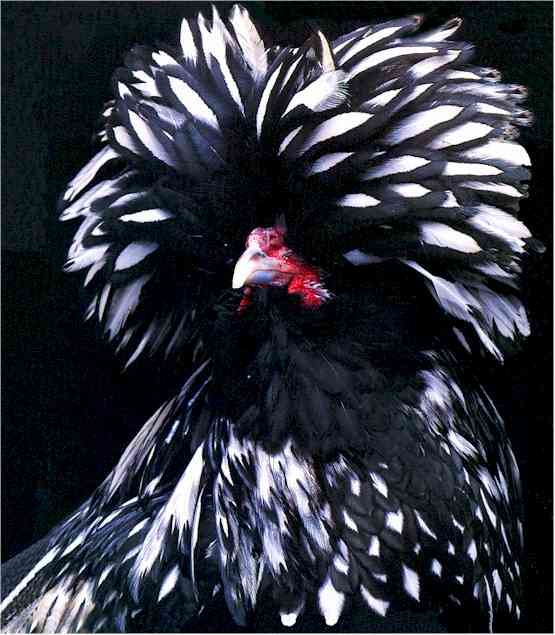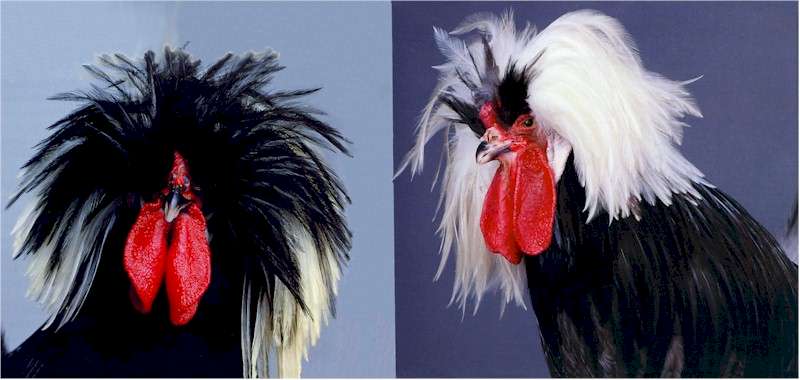Bad Feather Days
Beauty Parlour ChicksI did not become a vegetarian for my health, I did it for the health of the chickens. - Isaac Bashevis Singer Chickens, like all birds, are visually oriented. The size of the eyeball permits visualisation of a relatively large image. This accounts for the ability of chickens to see even the tiniest food particles, like seeds. Chickens do not hear as well as they can see, but their ears are reasonably well developed and useful. They do not have an external ear, but rather a round opening that is surrounded by a disc and hidden by tiny feathers. Their olfactory (smelling) sense is poorly developed. Chickens communicate by voice and gestures. Crowing announces the morning just at the break of dawn. The hen's loud, excited cackle announces an egg just laid. Clucking sounds are the distinctive voice sounds of a broody hen and the contact assurance of a mother for her chicks.
Polish Joke: Polish Chickens Are Really from ItalyThese chickens were thought to have developed near the banks of the Po River - hence their name. Polish are an unusual and beautiful breed. They have a crest (some also possess a beard and muffs), are small, tightly feathered birds, fairly active despite restricted vision due to their large "head gear." They need plenty of space to avoid damaging each other's crests by picking. Ice forming in their crests from drinking water can be a problem in cold weather. And sometimes their crests restrict vision and cause them to be easily frightened.
FrizzleThe Frizzle Poland was created in Holland by Mr Airie Bolan. His inspiration came from a painting by Van Gink, a famous artist. It started with the use of long legged Japanese Bantam Frizzle. It took several years to create but, between 1989 and 1991, the Frizzle Poland became recognised giving us a superb new breed. Today the popularity of the Frizzle Poland is extremely high and is now also standardised by the British Poultry Club.
Polish Frizzle Bantam White Hen Mimics Cockerel after Fox Raid
Miss Millie, a rare Frizzled Polish variety, crows at dawn and struts around the farmyard like a proud male. Her owner Judy Cook, from Winscombe, near Weston-super-Mare, Somerset, said Miss Millie took on the cockerel characteristics after her mate and all the other females in the yard were killed by a fox. "She's the only one now and she's acting just like a cockerel. I have never seen anything like it. Hens don't crow, it's as simple as that. It's totally unheard of." Mrs Cook believes the four-year-old chicken could be trying to take her mate's place. Miss Millie, who has extravagant plumage on the lines of the Seasame Street character Big Bird, now thinks nothing of coming into the family home and playing with the dogs. Mrs Cook said, "She's very confident - certainly one of a kind." Source: www.ananova.com Tuesday 7th August 2001
Polish Frizzle Golden-Laced While listed in the Standard as a breed, frizzling is a genetic modification that can be easily introduced into any population of chickens. It causes each feather to curl back toward the bird's head instead of lying naturally pointed toward the tail. The feathers can sometimes be quite brittle.
LaceThe Golden Lace (see photo above for the frizzle variety) comes non bearded and bearded. Everything is similar to Silver Lace (see photo below) except the colour. The Golden Lace plumage is golden bay laced with lustrous black. The Silver Lace Polish also comes in non bearded and bearded varieties. The comb, face and wattles are a bright red, the beak is dark horn and eyes reddish bay. The ear lobes are white with no discoloration; the leg shanks and toes are slate blue. The cockerel and pullet crest is black with white lacing and after the first moult should be white with lustrous black lacing. The non bearded male wattles are rounded on the bottom and of even length with no disfiguration. The wattle on the female is very small to nonexistent.
Polish Silver Lace
White CrestedThe Polish White Crested Black is non bearded. Wattles, face and comb are a bright red, the face smooth and without feathers. The ear lobes should be white without any discolouration. Beak is a blue/black, eyes are reddish bay color, leg shanks and toes a dark slate. The body's plumage is a lustrous, greenish black. The crest is white, very large, profuse and free from splits or parting. A small amount of black in the front is allowed, but the smaller the better. The crest is as high as wide (a pancake crest is a fault). The White Crested Blue Polish is the same as the White Crested Black except plumage is blue with black lacing in the USA - in other countries, the plumage is a solid blue.
Polish White-Crested Black and Blue Source: a fascinating coffee-table-type book called Extraordinary Chickens by Stephen Green-Armytage. The book had dozens of pictures of - well - extraordinary chickens. For more pages of photos of unusual chickens, please see the preceding two pages, This Doesn't Fly (especially the bottom article, "Hairless Joe Chicken") and Something to Crow About and the following page, You Elegant Fowl. Some information on these pages was taken from ansi.okstate.edu/poultry/chickens and honoluluzoo.org/bantam_chicken.htm.
For more on animals, including reptiles, crustaceans, arachnids, insects, fish, birds, pets, livestock, rodents, bears, primates, whales and Wellington's waterfront, click "Up" below to
take you to the Table of Contents for this Animals section. |
 Animals
Animals Animation
Animation Art of Playing Cards
Art of Playing Cards Drugs
Drugs Education
Education Environment
Environment Flying
Flying History
History Humour
Humour Immigration
Immigration Info/Tech
Info/Tech Intellectual/Entertaining
Intellectual/Entertaining Lifestyles
Lifestyles Men
Men Money/Politics/Law
Money/Politics/Law New Jersey
New Jersey Odds and Oddities
Odds and Oddities Older & Under
Older & Under Photography
Photography Prisons
Prisons Relationships
Relationships Science
Science Social/Cultural
Social/Cultural Terrorism
Terrorism Wellington
Wellington Working
Working Zero Return Investment
Zero Return Investment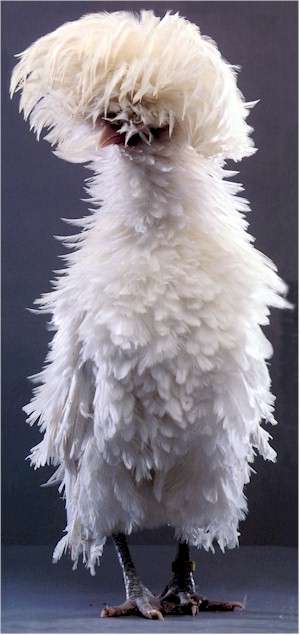
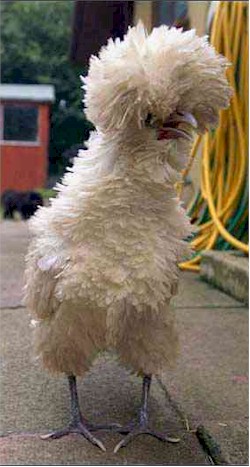
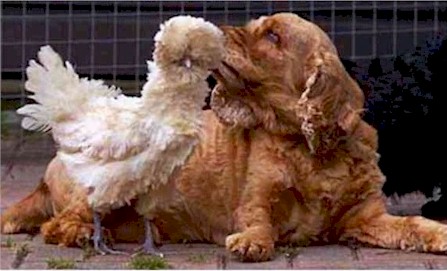 A grieving chicken has started impersonating a cockerel after its mate was killed by a fox.
A grieving chicken has started impersonating a cockerel after its mate was killed by a fox.
